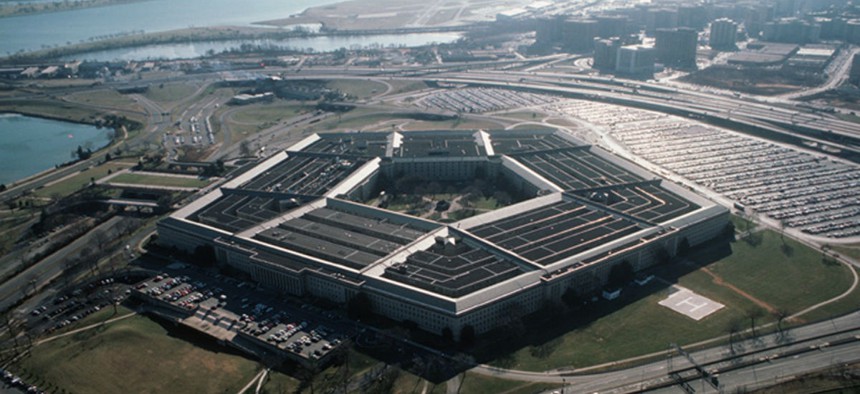
Defense Department file photo
The Pentagon Is Moving 13,000 Civilians Out of the GS System This Year
Reforms would give managers more flexibility in controlling workforce, officials say.
The Air Force is transitioning 13,000 civilian employees away from the General Schedule toward a new, more flexible personnel system.
As part of an ongoing initiative called AcqDemo, the Air Force Material Command will nearly double the number of employees who currently take part in the modernization effort. The Air Force has maintained the system is not a pay-for-performance program, though it does consolidate pay bands and reduce the burdens for doling out raises and bonuses.
Congress originally created AcqDemo -- formally known as the Acquisition Demonstration Project -- in 1996 to give managers greater control over the Defense Department’s acquisition workforce. Various department entities have moved their personnel onto the system, with 16,000 civilians currently participating. About 3,000 of those are Air Force staff.
The 13,000 additional Air Force civilians will be moved to the AcqDemo system by June 12. In the most recent Defense authorization bill, Congress authorized the program to continue through 2020. The overwhelming majority of participating employees do not have union representation.
The pay banding, or broadbanding, system will consolidate the 15 GS grades to four categories. The current job classification process is “both time consuming and costly,” according to internal Air Force documents obtained by Government Executive. The AcqDemo system creates “more flexibilities for setting pay," according to the documents, and “provides a direct link between levels of individual contribution and the compensation received.” Air Force employees making the transition are guaranteed not to sustain a pay cut as a result of the change.
Under President George W. Bush, the Defense Department moved all of its civilians to a pay banding system known as the National Security Personnel System. That overhaul proved overwhelmingly unpopular and was scrapped just a few years after it was launched, however, as Defense employees were transitioned back to the GS pay scale early in President Obama’s first term. The Air Force noted in its documents concerns would likely arise from employees that the AcqDemo was simply NSPS by another name, but officials maintained that those fears would be unfounded.
“Many employees will resist AcqDemo, including many who will immediately compare it to the National Security Personnel System used by DoD a few years ago and ultimately terminated,” the Air Force noted in a document. “Rumors will spread that AcqDemo could be a repeat of the failed NSPS.”
While broadbanding would simplify and eliminate “substantial paperwork” for employees to receive a promotion or pay raise -- and while the documents boast of the “direct link” between individual accomplishment and pay -- the Air Force said it does not amount to the pay-for-performance approach undertaken by NSPS. A performance-based system measures how well an employee does against defined objectives, while the Air Force said the new AcqDemo creates a “contribution-based” system in which employees are evaluated against a “continuum of work and job outcomes along a value scale.”
AcqDemo reduces the 22 “occupational families” in the GS system to just three: Business Management and Technical Management, Technical Management Support, and Administration Support.
The Air Force called the initiative a “win-win” for managers and employees, as it gives the rank-and-file more support for “personal and professional growth” and managers more “control and flexibility.”
Employees in the system are still eligible for the same pay increases as provided by the president or Congress for GS workers most years. AcqDemo also creates a pool of money equivalent to at least 2 percent of each employee’s salary, however, which is used for pay increases above the general raise. The Air Force said this system would bring more fairness in the pay system, rather than basing it on “amount of work accomplished and job longevity.”
“Equity in pay is achieved by making annual salary adjustments that move toward the same pay for the same contribution,” the Air Force said. “This means that those who are underpaid for their contribution will have larger increases and those who are overpaid for their contribution will have smaller increases.”
Air Force officials explained in the documents the system allows for “seamless” salary increases without formal promotions or step increases.
The Air Force said it will “continue discussions” with the American Federation of Government Employees to implement the new personnel system across the entire Material Command’s civilian workforce. For now, AFGE has agreed to allow both bargaining and non-bargaining employees to participate at Arnold Air Force Base in Tennessee as a trial. Of the 13,000 total civilians the Air Force is converting, just 208 are bargaining unit employees. While the demonstration project is set to expire in 2020, the Air Force said it expects legislative action to make the program permanent.
Separately, Defense Secretary Ash Carter has pushed his “Force of the Future” initiative, which would, among other things, move a large swath of the department’s civilian employees out of the GS personnel system. A draft proposal of the overhaul called the GS system “outdated, rigid and representative of a workforce demographic from more than 60 years ago.” It said the change would bring more flexibility to “hiring, determining compensation, managing performance and promotions.”
AFGE National President J. David Cox pushed back on that initiative, saying it represented a “retread of failed policies from the Bush administration.” AFGE declined to comment specifically on the Air Force conversion.







